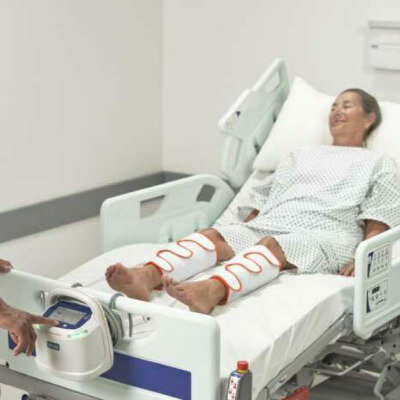IVC Filters Tied to Higher Mortality in Seniors with PE
|
By HospiMedica International staff writers Posted on 25 Dec 2018 |
Elderly patients with acute pulmonary embolism (PE) who receive an inferior vena cava (IVC) filter face a higher death risk, according to a new study.
Researchers at New York-Presbyterian Hospital/Columbia University Medical Center (NYP; New York, NY, USA), Universidad de Alcalá (Madrid, Spain), and Brigham and Women’s Hospital (BWH; Boston, MA, USA) conducted a study that examined data from 214,000 Medicare inpatient claims so as to evaluate the association between the use of IVC filters and mortality rates in older patients (mean age 77.8 years) who were hospitalized for acute PE. Of these patients, 13.4% received an IVC filter.
The results revealed that patients that received an IVC filter had a higher 30-day mortality rate (11.6%) than those who did not receive a filter (9.3%). One-year mortality rates among those who survived longer than 30 days were higher in unadjusted analysis (20.5%) in the IVC filter group, compared to the non-IVC-filter group (13.4%). Results were similar in matched cohort analyses, where the IVC filter group had 61% higher odds for 30-day mortality and 2.19-fold increased odds for one-year mortality compared with the non-filter group. The study was published on December 10, 2018, in JAMA Internal Medicine.
“Until we obtain additional high-quality data from prospective (ideally randomized) studies, we caution against the overuse of IVC filters in the broad population of patients at-risk of venous thromboembolism (VTE),” said lead author Behnood Bikdeli, MD, of NYP. “There may be still a small subset of patients, including those with clinically important acute VTE and absolute contraindication for anticoagulation, or recurrent PE despite optimal anticoagulation, in whom use of IVC filters may be considered according to the expert guidelines.”
Since the invention of the permanent percutaneous IVC filter in 1973 and the retrievable IVC filter in the 1990s, its use has become a standard part of treatment for select patients with acute lower-extremity venous thrombosis who cannot receive anticoagulation. Placement of an IVC filter is thus frequently considered in trauma patients because of the high risk of VTE associated with traumatic injury and the risks of anticoagulation in this population. In recent years, the U.S. Food and Drug Administration (FDA) raised concerns about the safety of IVC filters, and some studies have indicated a temporal decrease in the use of this technology.
Related Links:
New York-Presbyterian Hospital/Columbia University Medical Center
Universidad de Alcalá
Brigham and Women’s Hospital
Researchers at New York-Presbyterian Hospital/Columbia University Medical Center (NYP; New York, NY, USA), Universidad de Alcalá (Madrid, Spain), and Brigham and Women’s Hospital (BWH; Boston, MA, USA) conducted a study that examined data from 214,000 Medicare inpatient claims so as to evaluate the association between the use of IVC filters and mortality rates in older patients (mean age 77.8 years) who were hospitalized for acute PE. Of these patients, 13.4% received an IVC filter.
The results revealed that patients that received an IVC filter had a higher 30-day mortality rate (11.6%) than those who did not receive a filter (9.3%). One-year mortality rates among those who survived longer than 30 days were higher in unadjusted analysis (20.5%) in the IVC filter group, compared to the non-IVC-filter group (13.4%). Results were similar in matched cohort analyses, where the IVC filter group had 61% higher odds for 30-day mortality and 2.19-fold increased odds for one-year mortality compared with the non-filter group. The study was published on December 10, 2018, in JAMA Internal Medicine.
“Until we obtain additional high-quality data from prospective (ideally randomized) studies, we caution against the overuse of IVC filters in the broad population of patients at-risk of venous thromboembolism (VTE),” said lead author Behnood Bikdeli, MD, of NYP. “There may be still a small subset of patients, including those with clinically important acute VTE and absolute contraindication for anticoagulation, or recurrent PE despite optimal anticoagulation, in whom use of IVC filters may be considered according to the expert guidelines.”
Since the invention of the permanent percutaneous IVC filter in 1973 and the retrievable IVC filter in the 1990s, its use has become a standard part of treatment for select patients with acute lower-extremity venous thrombosis who cannot receive anticoagulation. Placement of an IVC filter is thus frequently considered in trauma patients because of the high risk of VTE associated with traumatic injury and the risks of anticoagulation in this population. In recent years, the U.S. Food and Drug Administration (FDA) raised concerns about the safety of IVC filters, and some studies have indicated a temporal decrease in the use of this technology.
Related Links:
New York-Presbyterian Hospital/Columbia University Medical Center
Universidad de Alcalá
Brigham and Women’s Hospital
Latest Critical Care News
- Soft Robots Could Donate Their Heart to Humans
- Bioadhesive Strategy Prevents Fibrosis Around Device Implants on Peripheral Nerves
- Miniature Non-Invasive Robotic Catheters to Improve Infertility Treatments
- Stick-On Patch Monitors Baby's Movements In Utero
- EEG-Based AI Technology Accurately Diagnoses Alzheimer’s and Dementia
- Robot Lymphatic System Paves Way for Self-Powered Wearables and Machines
- Focused Ultrasound Technique Successfully Treats Pediatric Brain Cancer
- Nasal Drops Fight Brain Tumors Noninvasively
- AI Helps Optimize Therapy Selection and Dosing for Septic Shock
- Glowing Bacteria ‘Pills’ for Detecting Gut Diseases Could Eliminate Colonoscopies
- Skin-Permeable Polymer Patch Delivers Insulin Non-Invasively Through Skin
- Nanogel Technology Almost 100% Effective in Destroying Drug-Resistant Bacteria Within Hours
- Wearable Ultrasound Sensor Delivers Noninvasive Treatment Without Surgery
- Gel-Free ECG System to Transform Heart Health Diagnosis
- Biodegradable Patch Repairs Damaged Tissue After Heart Attack
- Magnetically Guided Microrobots to Enable Targeted Drug Delivery

Channels
Surgical Techniques
view channel
Minimally Invasive Surgery Proven Safe and Effective for Complex ‘Whipple’ Procedure
Tumors of the pancreatic head often require a highly complex operation known as pancreatoduodenectomy or the Whipple procedure. This surgery involves removing multiple structures and creating several internal... Read more
Catheter-Based Procedures Offer Less Invasive Option for Treatment of Valvular Disease
Valvular heart disease, caused by tight or leaky valves between heart chambers, affects up to 10% of older adults and leads to more than 120,000 deaths globally each year. Traditional open-heart surgery... Read morePatient Care
view channel
Revolutionary Automatic IV-Line Flushing Device to Enhance Infusion Care
More than 80% of in-hospital patients receive intravenous (IV) therapy. Every dose of IV medicine delivered in a small volume (<250 mL) infusion bag should be followed by subsequent flushing to ensure... Read more
VR Training Tool Combats Contamination of Portable Medical Equipment
Healthcare-associated infections (HAIs) impact one in every 31 patients, cause nearly 100,000 deaths each year, and cost USD 28.4 billion in direct medical expenses. Notably, up to 75% of these infections... Read more
Portable Biosensor Platform to Reduce Hospital-Acquired Infections
Approximately 4 million patients in the European Union acquire healthcare-associated infections (HAIs) or nosocomial infections each year, with around 37,000 deaths directly resulting from these infections,... Read moreFirst-Of-Its-Kind Portable Germicidal Light Technology Disinfects High-Touch Clinical Surfaces in Seconds
Reducing healthcare-acquired infections (HAIs) remains a pressing issue within global healthcare systems. In the United States alone, 1.7 million patients contract HAIs annually, leading to approximately... Read moreHealth IT
view channel
EMR-Based Tool Predicts Graft Failure After Kidney Transplant
Kidney transplantation offers patients with end-stage kidney disease longer survival and better quality of life than dialysis, yet graft failure remains a major challenge. Although a successful transplant... Read more
Printable Molecule-Selective Nanoparticles Enable Mass Production of Wearable Biosensors
The future of medicine is likely to focus on the personalization of healthcare—understanding exactly what an individual requires and delivering the appropriate combination of nutrients, metabolites, and... Read moreBusiness
view channel
Philips and Masimo Partner to Advance Patient Monitoring Measurement Technologies
Royal Philips (Amsterdam, Netherlands) and Masimo (Irvine, California, USA) have renewed their multi-year strategic collaboration, combining Philips’ expertise in patient monitoring with Masimo’s noninvasive... Read more
B. Braun Acquires Digital Microsurgery Company True Digital Surgery
The high-end microsurgery market in neurosurgery, spine, and ENT is undergoing a significant transformation. Traditional analog microscopes are giving way to digital exoscopes, which provide improved visualization,... Read more
CMEF 2025 to Promote Holistic and High-Quality Development of Medical and Health Industry
The 92nd China International Medical Equipment Fair (CMEF 2025) Autumn Exhibition is scheduled to be held from September 26 to 29 at the China Import and Export Fair Complex (Canton Fair Complex) in Guangzhou.... Read more













